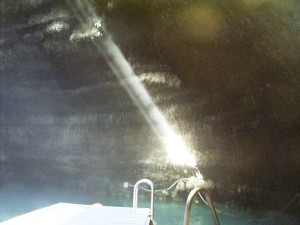I like to tell people that in Utah, we do things a little bit differently. Utah is the second driest state in the United States. We don’t get that much rain and snow. What we do have, though, is mountains. Mountains are formed by earthquakes, and the earth’s crust is somewhat thinner here. That means we have hot springs. Some are small and only result in a bit of steam or the occasional bit of fog in the winter. Others are big enough to dive in. Some of our hot springs are on land that has been developed. They are times of the year when you can go skiing in the morning, shoot a round of golf and then make a night dive. That night dive can be in 95F/35C water! All dives in Utah are Altitude dives (over 1000feet/300m above sea level). Normally, we warn divers to avoid getting cold when altitude diving. In Utah, we have to warn them about getting too hot.
Enter the Hot Spring Diver PADI Distinctive Specialty course. When diving in new and different situations, you should receive appropriate training. When you dive in hot water, you should know what you’re getting in to.
The Hot Spring Diver specialty course covers:
- where do you find hot springs
- planning for diving in hot springs
- preventing problems with hot spring diving (hyperthermia and dehydration)
- Making two hot spring dives
If you learned to dive in the Intermountain West, chances are you’ve been in a hot spring. If not, you should try it. If you have, remember you can always learn more about the dive sites and how to be better and safer divers. Some hot springs are only slightly warmer than the nearby mountain lakes. Some are hot enough that they can only be safely accessed during winter. Others are so hot that you will be burned if you enter them. Be informed. Be prepared. Become a Hot Spring Diver!
Learn more about Hot Spring Diving here.

Pingback: What’s In Your Logbook?
Pingback: What’s In Your Logbook? | DiveYeti